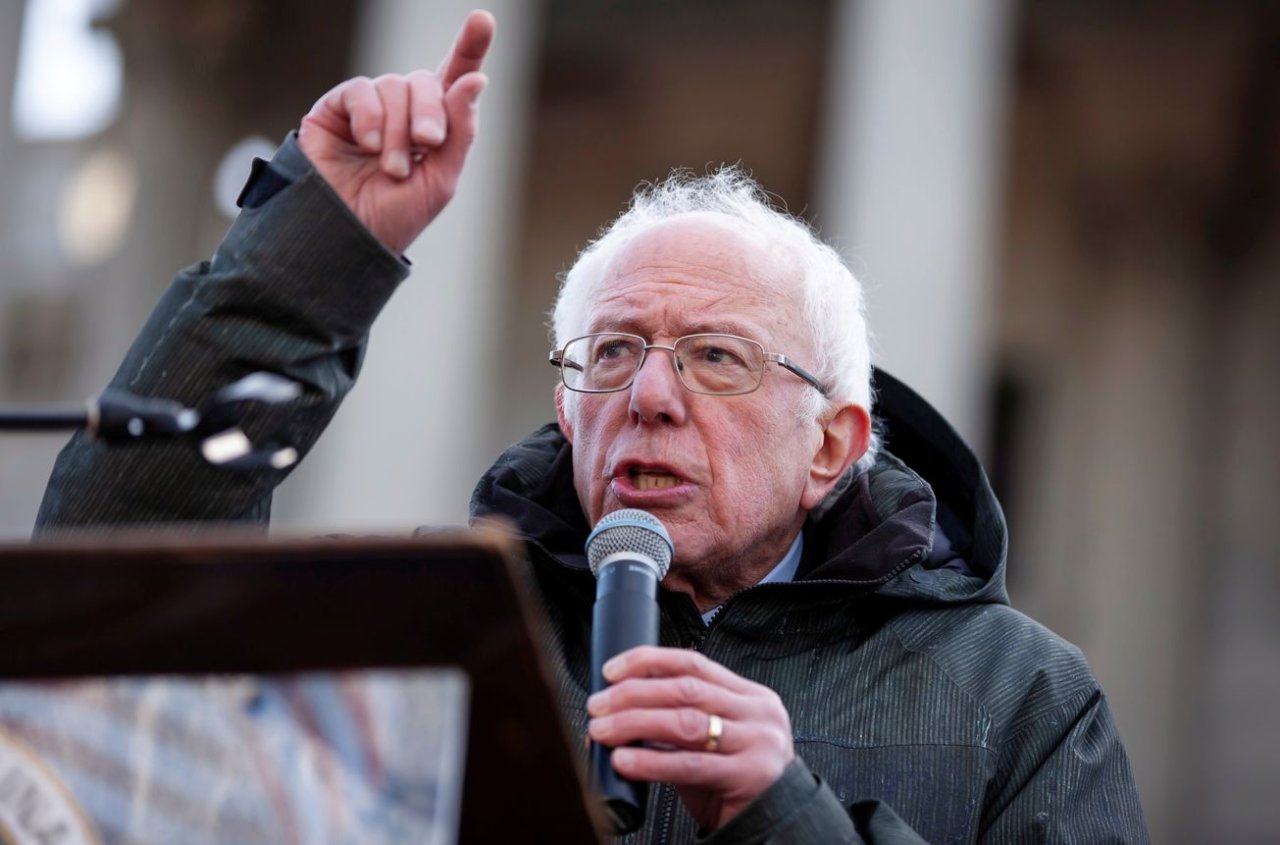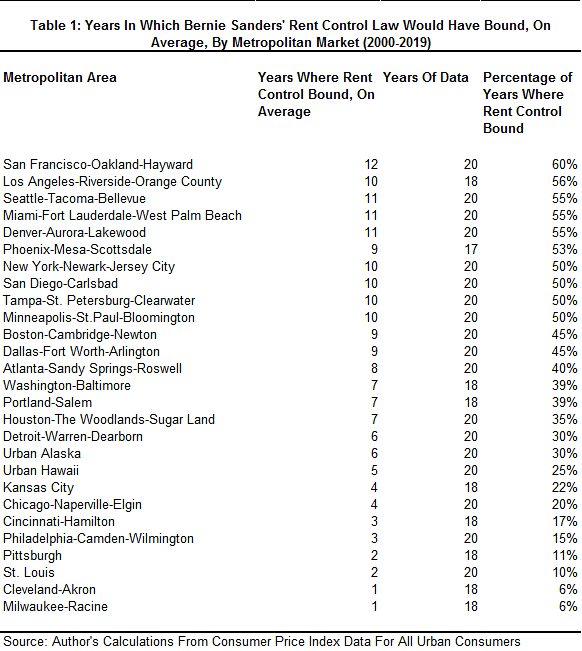
No, Bernie Sanders' Idea for National Rent Control Is a Terrible Idea
Bad economics.
by Ryan Bourne“Landlords cannot be allowed to raise rents to whatever they want, whenever they want,” Senator Bernie Sanders boomed on Twitter in November. “We need…a national rent control standard.” Now, his presidential campaign advocates one: under Sanders’ housing proposals, all landlords nationwide would only be able to increase rents annually by one and a half times the rate of inflation or 3 percent, whichever is higher. Assuming the current CPI for Urban Consumers is the inflation measure used, that would mean a rent increase cap today of just 3.4 percent.
Given the likely unconstitutionality of a truly national rent control law, one suspects Sanders should be taken seriously but not literally. What he is really doing here is endorsing a spate of new rent control laws across states, encouraging left‐wing activists to push for more stringent restrictions elsewhere. California has already instituted a 5 percent plus inflation cap for older buildings. Oregon has passed a rent increase cap of seven percent per year above CPI. New York just expanded protections for existing rent stabilized tenants and is expected to follow the others with a proposal for a general rent cap.
But that Sanders’ national proposal probably won’t or can’t be implemented doesn’t mean his reasoning won’t damage housing policy across the country. His claim that landlords can charge “whatever they want” entrenches the idea that rents are set through greed or market power, not supply and demand. And if crude, low level rent increase caps are implemented even in individual cities, it could have disastrous consequences in “hot” markets – particularly given proposals like his are shorn of the exemptions one usually sees for small‐time landlords, new properties or vacant units, that can provide a safety valve for the rental market.
To see the folly of a national rent policy, consider the differential state of major U.S. housing markets. According to a Demographia report last week, Rochester, New York has a median house price just two‐and‐a‐half times the median income for the city. Similarly affordable housing can be found in Cleveland, Ohio and Oklahoma City (both 2.7 median multiples). On the other end of the spectrum, major Californian housing markets such as Los Angeles, San Jose, and San Francisco all have mean multiples above 8, while Seattle (5.5), Miami (5.4), and New York (5.4) are still deemed “severely unaffordable.”
Given housing affordability varies so much, we shouldn’t be surprised that rents similarly differ by locality. And if we accept that rents differ across the country for similar housing because of different household sizes, incomes, land use and zoning laws, and more, it stands to reason that average rents will change at different rates year‐to‐year as these supply and demand factors vary.
Looking across the last 20 years shows this clearly (see Table 1). In the broad housing markets around San Francisco, Seattle, Miami and Denver, average rent increases have exceeded what Bernie Sanders’ proposal would allow in over one of every two years. In contrast, cities such as Milwaukee, Cleveland, and St Louis have rarely seen rent increases exceed Sanders’ arbitrary cap. Within cities, we’d expect differences by neighborhood too (though perhaps with lower variance).

Is there any reason to suspect that landlords have been greedier in Miami than Milwaukee, or Seattle than St Louis? Or is it more likely that supply and demand trends have been different across cities over that 20 years? This evidence, plus the fact that rents within individual cities’ neighborhoods tend to quickly converge for certain property types and size, suggests that landlords cannot raise rents to “whatever they, whenever they want.” In reality, they are constrained both by tenants’ ability to pay and the availability of substitute properties. Or, to put it another way, by supply and demand.
Once one accepts that rental prices are overwhelmingly the product of market forces, not landlord greed, you see why rent control, especially as Sanders’ envisages, is such a misguided idea. It effectively seeks to drown out the message that rising rents is submitting – of an increased relative scarcity of rentable accommodation that has led rents to rise to clear the market. Instead, capping rents forces on the market the comforting lie that property is abundant. That produces a whole range of well‐documented consequences.
Consider neighborhoods where market rents are expected to rise in the coming year beyond Sanders’ current 3.4 percent cap. The rent control will therefore bind, and if market rents continue increasing rapidly (perhaps because of an unresponsive supply of new housing to demand) then rents paid will become lower and lower relative to the underlying market rent. For hot rental markets:
- Once it becomes clear rent controls are likely to be implemented, some landlords may seek to raise rents today before the cap becomes law, second‐guessing how market rents will evolve in the very near future.
- Once the rent control binds, there will be a shortage of property relative to the quantity demanded. Existing landlords will, on the margin, seek to find ways to convert rental accommodation into non‐controlled forms of accommodation, such as condos, offices, use through AirBnB, owner‐occupancy, and more.
- Since rents cannot adjust to the new market reality over time, and there are no exemptions for new properties, capital investment in new rentable accommodation will fall in neighborhoods affected. Existing buildings will likewise be knocked down and replaced with buildings for other uses. These effects will be exacerbated if landlords perceive rent control to be the precursor for other restrictions on how they use their buildings or choose their tenants. The overall supply of rentable accommodation in the market will therefore fall relative to where it would have been.
- Existing tenants who do not want to move will benefit significantly from the controls, with big rent savings. But over time that will mean many people being in accommodation that is the wrong size or location for them. Extensive wait lists for properties and black‐market bribes will likely proliferate.
- Ordinarily, crude rent controls can lead to a deterioration of property quality. Landlords have incentives to either allow the property quality to deteriorate so that the market rent falls to the controlled rent or else to change the tenure type to non‐controlled forms. In the case of Sanders’ proposal, however, landlords can apply for waivers from the controls if significant capital improvements are made. In very hot markets there are therefore big incentives for rapid gentrification – converting to very expensive, high‐end properties and then fixing rents very high initially to reflect binding rent controls into the future.
In short, a Sanders national rent control proposal would bring a lot of economic damage. But even if implemented more locally, such a crude rent cap would bring significant downsides to local housing markets, and the economy more broadly. And all based on the misguided idea that landlords have vast market power to set rents.
This article by Ryan Bourne originally appeared in the CATO at Liberty blog in 2019.
Image: Reuters.